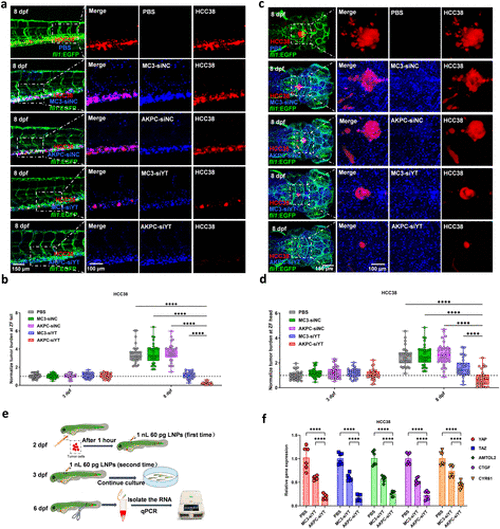Fig. 6
- ID
- ZDB-FIG-250508-21
- Publication
- Zhao et al., 2025 - Peptide-Modified Lipid Nanoparticles Boost the Antitumor Efficacy of RNA Therapeutics
- Other Figures
- All Figure Page
- Back to All Figure Page
|
Therapeutic antitumor effect of AKPC-siYT in vivo on HCC38 xenografts. a, Confocal image of HCC38-mCherry tumor burden (in red) with LNPs-siRNA (in blue) in the circulation of zebrafish at 8 dpf. Green represents vessels of zebrafish embryos. b, The relative intensity of red fluorescence (the ratio of fluorescence intensity of each group at 8 dpf to that of the PBS group at 3 dpf) was used to measure tumor burden at CHT sites of zebrafish at 3 dpf and 8 dpf (n = 30/group). c, Confocal image of HCC38 tumor burden with LNPs-siRNA in the hindbrain at 8 dpf. d, The relative intensity of red fluorescence (the ratio of fluorescence intensity of each group at 8 dpf to that of the PBS group at 3 dpf) was used to measure tumor burden in the hindbrain of zebrafish at 3 and 8 dpf (n = 30/group). Two-way ANOVA multiple comparisons were used to determine the significance of the comparisons of data indicated in b and d (*p < 0.05; **p < 0.01; ***p < 0.001; ****p < 0.0001). In all panels, error bars represent mean ± s.d. e, Schematic representation of RNA isolation of tumor cells from the tail of zebrafish and RT-PCR detection. f, RT-PCR results of YAP/TAZ and downstream gene expression in zebrafish after codelivery of siYAP and siTAZ at 8 dpf. Two-way ANOVA was used to determine the significance of the comparisons of data (*p < 0.05; **p < 0.01; ***p < 0.001; ****p < 0.0001). In all panels, error bars represent mean ± s.d. (n = 3). |

